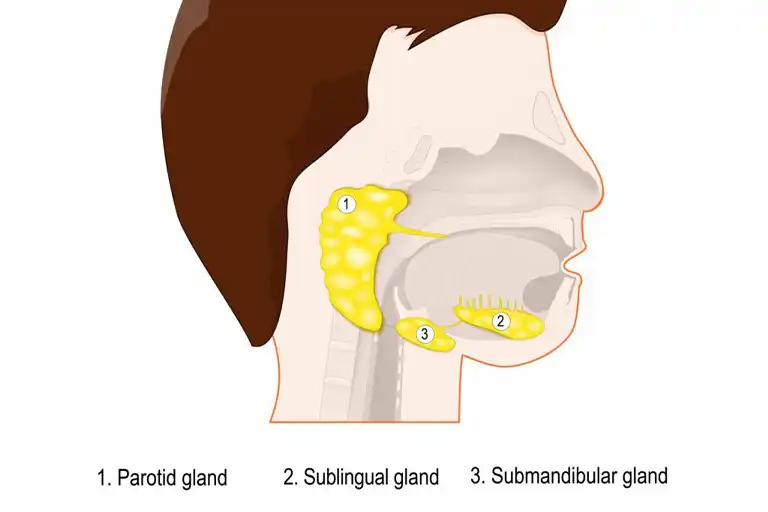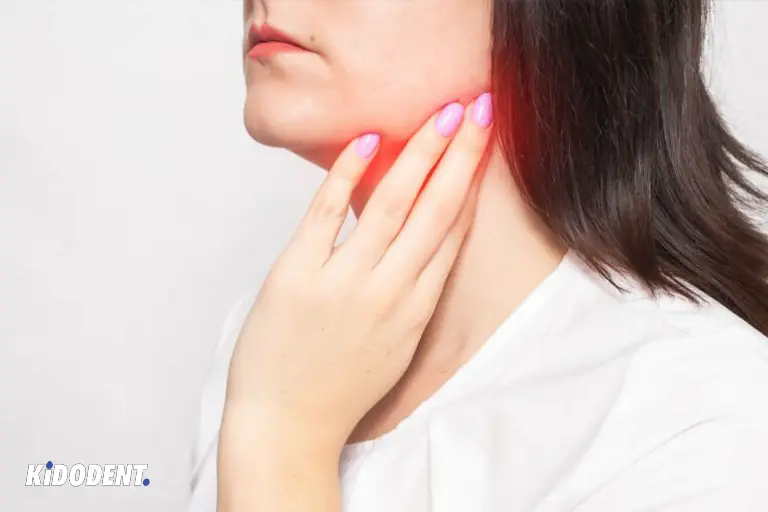It’s just the face and mouth you see, but just under the skin, you will find facial veins, artery to carry blood, facial nerves, muscles and yes let’s not forget our salivary glands.
What are salivary glands?
Salivary glands are the organs that produce saliva into the mouth. You may want to ask ‘What is saliva?’ saliva is what makes your mouth moisturized and lubricated. Saliva contains mucus or serous or combination of both. Mucus is slimy and sticky and serous is watery and contain protein, which has enzyme to help with the digestion of our foods. Salivary glands consist of fat tissues and cells that release saliva with the help of ducts.
Three types of glands: anatomy and function
There are three major salivary glands. Parotid gland is the largest and drains saliva into the mouth near your upper second molar tooth. It uses Stensen’s duct to deliver saliva in your oral cavity. Parotid gland is located between your ear and down to the upper part of your lower jaw. Two other major glands are submandibular gland and sublingual gland. Submandibular is located in your lower jaw deep in the muscles of your mandibular (lower jaw). It uses Wharton’s duct to drain saliva into your mouth in front part of the mouth’s floor below your tongue. Sublingual is in your floor of the mouth below the membrane covering the floor of the mouth. Sublingual gland has small series of ducts that moisturize your mouth.

What is Wharton’s duct?
Each gland has its own duct, just like a pipe, that carries saliva to your mouth from different sites and location. If we make it simple, these ducts carry the lubricant that your mouth needs. Wharton’s duct is one of those ducts that keep the moisture of the floor of your mouth in balance and is an essential part in our mouth. It is around 5 cm in length, after passing through the muscles in floor of the mouth inside your lower jaw, it reaches out in front part of your floor of the mouth. Move up your tongue, you will see Wharton’s duct!
Why are salivary glands and Wharton’ duct important?
Any problems with salivary glands and associated ducts can disturb our natural mouth lubricant. Wharton’ duct can be at higher risk of infections and pain and in most case it is faced with problems like salivary stones, which can block the saliva from reaching the floor of your mouth.
Change in your saliva quality or lack of enough saliva in your mouth means:
- Xerostomia (dry mouth)
- Bad breath
- Gum diseases
- Plaque build ups and tooth decay
- Bacterial growth in your mouth
Common problems to salivary glands and ducts
Salivary glands like all other parts of our body can be at risk from injuries, infections (sialadenitis), tumors, cysts, sialoliths (salivary stones), and other common complications.
Salivary gland injuries
If injuries are near the ear along the cheeks to the upper lip, your parotid gland and its duct may be affected. On the other hand, if the injury causes damage to the floor of your mouth and below your lower jaw, it is possible that the salivary glands in that part, which include submandibular gland, sublingual gland, or Wharton’s duct can be damaged. These injuries usually can be blows, cuts, lacerations, and other types of facial and jaw trauma.
Xerostomia (dry mouth)
Low saliva production and changes in the quality of your saliva can lead to dry mouth, medically called xerostomia. But it is good to know about what causes this situation. You can have a temporary xerostomia and permanent dry mouth.
Temporary causes can be infections in your salivary gland, medications, hormonal changes, dehydration, sialolithiasis, and other risk factors. For permanent dry mouth, aging usually is one big factor. The higher the age, the more risks of xerostomia. Radiation therapy, diseases like renal disease, immunodeficiency diseases like HIV, and sjӧgren’s syndrome are important causes to name for permanent dry mouth.
Sialolithiasis
Sialolithiasis or salivary stone is the development of stones (sialoliths) in the ducts, which can block your gland and can cause pain and swelling. A salivary stone is more common in the Wharton’s duct or submandibular glands.
Depending on the location of your salivary gland and ducts, you will feel pain and swelling on that site. Why does sialolithiasis occur mostly in Wharton’s duct? Because here the saliva contains more calcium salt and the Wharton’s duct is longer, making it more at risk of calcium accumulation. When Wharton’s duct is blocked by salivary stones, you have pain on the floor of your mouth or under your tongue.
Sialadenitis
Sialadenitis is an infection in your glands and ducts mainly in the parotid gland and submandibular glands. It accompanies pain and swelling. The causes of sialadenitis can be blockage because of salivary stones (sialolithiasis), bacteria like Staphylococcus aureus, viral viruses such as mumps, influenza, and Epstein-Barr virus.
There are other factors that can lead to the development of sialadenitis like malnutrition and dehydration. Sometimes, the condition can be due to a chronic infection. In that case, the causes are usually related to immune system diseases like sjӧgren’s syndrome and rheumatoid arthritis.
Sjӧgren’s syndrome
Sjӧgren’s syndrome is an autoimmune disorder that happens more in women, in about 90% of cases. It causes dry mouth and dry eyes.
The exact causes are not known but environmental factors, genetics, viruses, and infections could be the main reasons for sjӧgren’s syndrome development. It can be associated with other systemic diseases mostly with rheumatoid arthritis.
What is important to know is that sjӧgren’s syndrome can cause problems to salivary glands by the appearance of symptoms like swollen gland (parotid gland). There are more complication that follows including xerostomia, gum diseases, dental caries, and changes in your taste.
